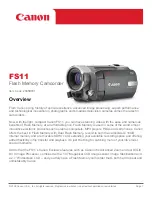
12-2
VL-E610S/VL-E610H
VL-E660S/VL-E96E
VL-E98E
This adapter is designed as a power supply for the camcorder as well as a quick charger for the battery used in the
camcorder.
As shown in the block diagram (Figure 12-1-1), the adapter consists of a separately excited switching regulator which uses
the control IC and a multi-functional circuit at the secondary side.
The primary side control section and the secondary side multi-functional circuit, composed mainly of surface mounted
devices, are mounted in a small portable casing for portable uses.
Available input voltage is 110 to 240V (50/60 Hz), so that this handy unit can be carried around and used all over the world.
The basic operation is controlled by the section to perform constant voltage control (designed to compare the operating
voltage with the secondary side reference voltage provided at a switching power supply), and constant current control,
as well as by the timer for quick battery charging, various detecting circuits, and sequence control section. This unit, as
an AC adapter, supplies constant voltage DC power through the 3-pin DC jack with a control terminal, and as a battery
charger, the unit starts the quick charging when the specific battery is loaded with the DC plug unconnected.
Fig. 12-1-1 Block diagram (Camcorder adapter)
12-1-2. Operation
1.Adapter mode
When the DC plug is attached to the adapter, the stable DC voltage (4.5V, 2A) is continuously supplied through the
DC jack to operate camcorder.
The power consumption is kept constant over the whole control input range, regardless of input fluctuation.
The output is 1.3 or more times higher than rated current so that the unit can withstand transition accompanied by VCR
starting current flow and rush current flow.
Also, for the adapter output, the overcurrent protector of specific characteristics ensuring power control against short-
circuiting from outside is used to protect the adapter from being damaged or broken down. It also prevents the
excessive heating inside the adapter.
Fig. 12-1-2
Charging characteristics In case
of 1500mAh Ni-Cd battery
2.Ni-Cd charge mode
This adapter, when Ni-Cd battery is attached, can be used as a quick
charger. This charging operation has three operating modes which are
switched successively.
The first stage is called the initial charging. A constant current 1.5A is
used to charge within voltage limit (5.7V) and time limit (set by 10 min
timer).
The voltage is limited in order to protect the battery against overvoltage
and overcharge which may occur due to recharging of fully charged
battery.
The time limit serves to prevent the charging error which may occur due
to initial voltage drop of inactive battery.
The second stage is a quick charging. As with initial charging, 1.5A
quick charge is performed within voltage limit (5.7V) and time limit set
by the timer (180 minutes) which are different from those of the initial
charging.
During quick charging, a voltage drop (-
∆
V phenomenon) of the battery
which occurs at the end of charging is detected, the charging is stopped,
and the next stage is started.
When charging current is 1.5A, the 1500mAh battery, and the under-
mentioned 2700mAh nickel-hydrogen battery are fully charged for
about 60 minutes and about 140 minutes, respectively.
Input
AC110-240V
50/60Hz
Rectifier/
Smoother
Insulating
transformer
Rectifier/
Smoother
ADP output (4.5 V, 2 A)
Battery terminal
Error
amplifier
Photocoupler
Filter
Primary
side
control
section
Inverter
Voltage switching
Current switching
Timer control
Charging/Discharging
control
Discharging
circuit
12-1. OPERATION MANUAL
12-1-1. Outline













































